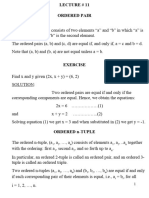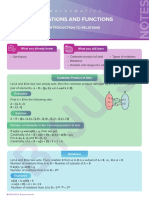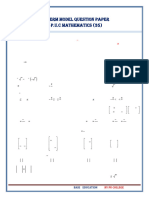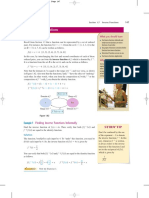Material Downloaded From - 1 / 14
Uploaded by
Prabith GuptaMaterial Downloaded From - 1 / 14
Uploaded by
Prabith GuptaCBSE
Class 12 Mathematics
Important Questions
Chapter 1
Relations and Functions
4 Marks Questions
1. Let T be the set of all triangles in a plane with R a relation in T given by
R = {(T1, T2): T1 is congruent to T2}.
Show that R is an equivalence relation.
Ans. R is reflexive, since every is congruent to itself.
(T1T2) R similarly (T2T1) R
since T1 T2
(T1T2) R, and (T2,T3) R
(T1T3) R Since three triangles are
congruent to each other.
2. Show that the relation R in the set Z of integers given byR={(a, b) : 2 divides a-b}. is
equivalence relation.
Ans. R is reflexive , as 2 divide a-a = 0
((a,b) R ,(a-b) is divide by 2
(b-a) is divide by 2 Hence (b,a) R hence symmetric.
Let a,b,c Z
If (a,b) R
And (b,c) R
Material downloaded from myCBSEguide.com. 1 / 14
Then a-b and b-c is divided by 2
a-b +b-c is even
(a-c is even
(a,c) R
Hence it is transitive.
3. Let L be the set of all lines in plane and R be the relation in L define if R = {(l1, L2 ):
L1 is to L2 } . Show that R is symmetric but neither reflexive nor transitive.
Ans. R is not reflexive , as a line L1 cannot be to itself i.e (L1,L1 ) R
L1 L2
L2 L1
(L2,L1) R
L1 L2 and L2 L3
Then L1 can never be to L3 in fact L1 || L3
i.e (L1,L2) R, (L2,L3) R.
But (L1, L3) R
4. Check whether the relation R defined in the set {1, 2, 3, 4, 5, 6} asR = {(a, b): b = a+1} is
Material downloaded from myCBSEguide.com. 2 / 14
reflexive, symmetric or transitive.
Ans. R = {(a,b): b= a+1}
Symmetric or transitive
R = {(1,2) (2,3) (3,4) (4,5) (5,6) }
R is not reflective , because (1,1) R
R is not symmetric because (1,2) R but (2,1) R
(1,2) R and (2,3) R
But (1,3) R Hence it is not transitive
5. Let L be the set of all lines in xy plane and R be the relation in L define as R = {(L1,
L2): L1 || L2} Show then R is on equivalence relation.
Find the set of all lines related to the line y=2x+4.
Ans. L1||L1 i.e (L1, L1) R Hence reflexive
L1||L2 then L2 ||L1 i.e (L1L2) R
(L2,L) R Hence symmetric
We know the
L1||L2 and L2||L3
Then L1|| L3
Hence Transitive . y = 2x+K
When K is real number.
6. Show that the relation in the set R of real no. defined R = {(a, b) : a b3 }, is neither
reflexive nor symmetric nor transitive.
Material downloaded from myCBSEguide.com. 3 / 14
Ans. (i) (a, a) Which is false R is not reflexive.
(ii) Which is false R is not symmetric.
(iii) Which is false
7. Let A = N N and * be the binary operation on A define by (a, b) * (c, d) = (a + c, b +
d)Show that * is commutative and associative.
Ans. (i) (a, b) * (c, d) = (a + c, b + d)
= (c + a, d + b)
= (c, d) * (a, b)
Hence commutative
(ii) (a, b) * (c, d) * (e, f)
= (a + c, b + d) * (e, f)
= (a + c + e, b + d + f)
= (a, b) * (c + e, d + f)
= (a, b) * (c, d) * (e, f)
Hence associative.
8. Show that if f: is defining by f(x) = and g:
is define by
g(x) = then fog = IA and gof = IB when ; IA (x) = x,
for all x A, IB(x) = x, for all x B are called identify function on set A and B
Material downloaded from myCBSEguide.com. 4 / 14
respectively.
Ans. gof (x) =
Which implies that gof = IB
And Fog = IA
9. Let f: N à N be defined by f(x) =
Examine whether the function f is onto, one – one or bijective
Ans.
f is not one – one
1 has two pre images 1 and 2
Material downloaded from myCBSEguide.com. 5 / 14
Hence f is onto
f is not one – one but onto.
10. Show that the relation R in the set of all books in a library of a collage given by R =
{(x, y) : x and y have same no of pages}, is an equivalence relation.
Ans. (i) (x, x) R, as x and x have the same no of pages for all x R R is reflexive.
(ii) (x, y) R
x and y have the same no. of pages
y and x have the same no. of pages
(y, x) R
(x, y) = (y, x) R is symmetric.
(iii) if (x, y) R, (y, y) R
(x, z) R
R is transitive.
11. Let * be a binary operation. Given by a * b = a – b + abIs * :
(a) Commutative
(B) Associative
Ans. (i) a * b = a – b + ab
b * a = b – a + ab
a * b b * a
(ii) a * (b * c) = a * (b – c + bc)
= a – (b – c + bc) + a. (b – c + bc)
Material downloaded from myCBSEguide.com. 6 / 14
= a – b + c – bc + ab – ac + abc
(a * b) * c = (a – b + ab) * c
= [ (a – b + ab) – c ] + ( a – b + ab)
= a- b + ab – c + ac – bc + abc
a * (b * c) (a * b) * c.
12. Let f: R à R be f (x) = 2x + 1 and g: R à R be g(x) = x2 – 2 find (i) gof (ii) fog
Ans. (i) gof (x) = g[f(x)]
= g (2x + 1)
= (2x + 1)2 – 2
(ii) fog (x) = f (fx)
= f (2x + 1)
= 2(2x + 1) + 1
= 4x + 2 + 1 = 4x + 3
13. Let A = R – {3} and B = R- {1}. Consider the function of f: A à B defined by
f(x) = is f one – one and onto.
Ans. Let x1 x2 A
Such that f(x1) = f(x2)
Material downloaded from myCBSEguide.com. 7 / 14
f is one – one
Hence onto
14. Show that the relation R defined in the set A of all triangles asR = { is
similar to T2 }, is an equivalence relation. Consider three right angle triangles T1 with
sides 3, 4, 5. T2 with
sides 5, 12, 13 and T3 with sides 6, 8, 10. Which triangles among T1, T2 and T3 are
related?
Ans. (i) Each triangle is similar to at well and thus (T1, T1) R
R is reflexive.
(ii) (T1, T2) R
T1 is similar to T2
T2 is similar to T1
(T2, T1) R
R is symmetric
(iii) T1 is similar to T2 and T2 is similar to T3
T1 is similar to T3
(T1, T3) R
Material downloaded from myCBSEguide.com. 8 / 14
R is transitive.
Hence R is equivalence
(II) part T1 = 3, 4, 5
T2 = 5, 12, 13
T3 = 6, 8, 10
T1 is relative to T3.
15. Determine which of the following operation on the set N are associative and which
are commutative.
(a) a * b = 1 for all a, b N
(B) a * b = for all a, b, N
Ans. (a) a * b = 1
b * a = 1
for all a, b N also
(a * b) * c = 1 * c = 1
a * (b * c) = a * (1) = 1 for all, a, b, c R N
Hence R is both associative and commutative
(b) a * b = , b * a =
Hence commutative.
(a * b) * c =
Material downloaded from myCBSEguide.com. 9 / 14
=
* is not associative.
17. Let A and B be two sets. Show that f: A B à B A such that f(a, b) = (b, a) is a
bijective function.
Ans. Let (a1 b1) and (a2, b2) A B
(i) f(a1 b1) = f(a2, b2)
b1 = b2 and a1 = a2
(a1 b1) = (a2, b2)
Then f(a1 b1) = f(a2, b2)
(a1 b1) = (a2, b2) for all
(a1 b1) = (a2, b2) A B
(ii) f is injective,
Let (b, a) be an arbitrary
Element of B A. then b B and a A
(a, b) ) (A B)
Thus for all (b, a) B A their exists (a, b) ) (A B)
Hence that
Material downloaded from myCBSEguide.com. 10 / 14
f(a, b) = (b, a)
So f: A B à B A
Is an onto function.
Hence bijective
18. Show that the relation R defined by (a, b) R (c, d) a + b = b + c on the set N N is
an equivalence relation.
Ans. (a, b) R (c, d) a + b = b + c where a, b, c, d N
(a, b ) R (a, b) a + b = b + a (a, b) N N
R is reflexive
(a, b) R (c, d) a + b
= b + c (a, b ) (c, d) N N
d + a = c + b
c + b = d + a
(c, d) R (a, b) (a, b), (c, d) N N
Hence reflexive.
(a, b) R (c, d) a + d = b + c (1) (a, b), (c, d) N N
(c, d) R (e, f) c + f = d + e (2) (c, d), (e, f) N N
Adding (1) and (2)
(a + b) + [(+f)] = (b + c) + (d + e)
a + f = b + e
(a, b) R (e, f)
Material downloaded from myCBSEguide.com. 11 / 14
Hence transitive
So equivalence
19. Let * be the binary operation on H given by a * b = L. C. M of a and b. find
(a) 20 * 16
(b) Is * commutative
(c) Is * associative
(d) Find the identity of * in N.
Ans. (i) 20 * 16 = L. C.M of 20 and 16
= 80
(ii) a * b = L.C.M of a and b
= L.C.M of b and a
= b * a
(iii) a * (b * c) = a * (L.C.M of b and c)
= L.C.M of (a and L.C.M of b and c)
= L.C.M of a, b and c
Similarity
(a * b) * c = L. C.M of a, b, and c
(iv) a * 1 = L.C.M of a and 1= a
Material downloaded from myCBSEguide.com. 12 / 14
=1
20. If the function f: R à R is given by f(x) = and g: R à R is given by g(x) = 2x – 3,
Find
(i) fog
(ii) gof. Is f-1 = g
(iii) fog = gof = x
Ans. (i) fog (x) = f [g(x)]
= f (2x – 3)
= x
(ii) gof (x) = g [f(x)]
= x
(iii) fog = gof = x
Yes,
21. Let L be the set of all lines in Xy plane and R be the relation in L define as R = {(L1,
L2): L1 || L2} Show then R is on equivalence relation.
Find the set of all lines related to the line y=2x+4.
Material downloaded from myCBSEguide.com. 13 / 14
Ans. L1||L1 i.e (L1, L1) R Hence reflexive
L1||L2 then L2 ||L1 i.e (L1L2) R
(L2, L) R Hence symmetric
We know the
L1||L2 and L2||L3
Then L1|| L3
Hence Transitive. y = 2x+K
When K is real no.
Material downloaded from myCBSEguide.com. 14 / 14
You might also like
- Relations, Functions Inverse Trigonometric Functions Relations Ordered PairNo ratings yetRelations, Functions Inverse Trigonometric Functions Relations Ordered Pair29 pages
- 12 Mathematics Impq CH01 Relations and Functions 01No ratings yet12 Mathematics Impq CH01 Relations and Functions 018 pages
- Class Xii Cumulative Class Test Math CH-1&2No ratings yetClass Xii Cumulative Class Test Math CH-1&23 pages
- Assignment - Chapter-1 - Relations and FunctionsNo ratings yetAssignment - Chapter-1 - Relations and Functions5 pages
- RELATION Anf Function Class 12 (1) - 230613 - 235541100% (1)RELATION Anf Function Class 12 (1) - 230613 - 235541287 pages
- Notes in Additional Mathematics with Examples and ExercisesFrom EverandNotes in Additional Mathematics with Examples and ExercisesNo ratings yet
- Unit 1 - Activity 1 - Dropbox-Function Domain and Range Worksheet-1hrNo ratings yetUnit 1 - Activity 1 - Dropbox-Function Domain and Range Worksheet-1hr4 pages
- 2nd Puc Maths Midterm Model Question Paper 2023No ratings yet2nd Puc Maths Midterm Model Question Paper 20235 pages
- Chapter-02: Relations and Functions: Basic Concepts100% (1)Chapter-02: Relations and Functions: Basic Concepts12 pages
- Worksheet 3: Even More Precalc!: Russell BuehlerNo ratings yetWorksheet 3: Even More Precalc!: Russell Buehler2 pages
- 6.inverse Trigonometric FunctionsTheoryNo ratings yet6.inverse Trigonometric FunctionsTheory25 pages
- Infinity Optional Mathematics Book 9 Final For CTP 2077100% (2)Infinity Optional Mathematics Book 9 Final For CTP 2077352 pages
- Function: SPM Additional Mathematics KSSMNo ratings yetFunction: SPM Additional Mathematics KSSM45 pages
- Discrete Maths: Exercises & Solutions: Propositional Equivalences, Predicates and QuantifiersNo ratings yetDiscrete Maths: Exercises & Solutions: Propositional Equivalences, Predicates and Quantifiers14 pages
- Precal2 2024 Inverse Trig Functions DoneNo ratings yetPrecal2 2024 Inverse Trig Functions Done24 pages
- BITS Pilani: Discrete Structures For Computer Science - FunctionsNo ratings yetBITS Pilani: Discrete Structures For Computer Science - Functions23 pages
- Chapter-1-Relations-and-Functions Ncert SolutionNo ratings yetChapter-1-Relations-and-Functions Ncert Solution56 pages
- (L3) - (JEE 3.0) - Relations & Functions - 7th April.100% (2)(L3) - (JEE 3.0) - Relations & Functions - 7th April.47 pages
- II Puc - Maths - 01 - Relations and FunctionsNo ratings yetII Puc - Maths - 01 - Relations and Functions6 pages
- Relations, Functions Inverse Trigonometric Functions Relations Ordered PairRelations, Functions Inverse Trigonometric Functions Relations Ordered Pair
- 12 Mathematics Impq CH01 Relations and Functions 0112 Mathematics Impq CH01 Relations and Functions 01
- RELATION Anf Function Class 12 (1) - 230613 - 235541RELATION Anf Function Class 12 (1) - 230613 - 235541
- Notes in Additional Mathematics with Examples and ExercisesFrom EverandNotes in Additional Mathematics with Examples and Exercises
- Unit 1 - Activity 1 - Dropbox-Function Domain and Range Worksheet-1hrUnit 1 - Activity 1 - Dropbox-Function Domain and Range Worksheet-1hr
- Chapter-02: Relations and Functions: Basic ConceptsChapter-02: Relations and Functions: Basic Concepts
- Infinity Optional Mathematics Book 9 Final For CTP 2077Infinity Optional Mathematics Book 9 Final For CTP 2077
- Discrete Maths: Exercises & Solutions: Propositional Equivalences, Predicates and QuantifiersDiscrete Maths: Exercises & Solutions: Propositional Equivalences, Predicates and Quantifiers
- BITS Pilani: Discrete Structures For Computer Science - FunctionsBITS Pilani: Discrete Structures For Computer Science - Functions
- (L3) - (JEE 3.0) - Relations & Functions - 7th April.(L3) - (JEE 3.0) - Relations & Functions - 7th April.

























































































